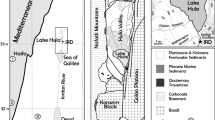Abstract
The long-term impact of Maya culture on a lowland tropical watershed is assessed, using data from a 9.2 m sediment core taken from deep water (28 m) in Lake Quexil. Human population growth, estimated by the 1980 archaeological survey, is associated with a shift in the composition of the sediment to a dominance by inorganic material, the Maya clay formation, beginning ca. 3500 B.P. Increasing settlement densities are correlated with accelerated influxes of phosphorus, carbonates, and siliceous sediment. However, chemical data do not track short-term population fluctuations closely. Because much of the sediment is delivered as colluvium, and not by running water, there is a lag between terrestrial disturbance and impact on the aquatic system. As an indication of this lag, contemporary high sedimentation rates are a residual of Maya activity that virtually ceased some 300–400 years B.P. Comparison of the deep-water core with a shallow-water (7 m) section, based on palynological correlation, reveals only minor differences in proximate chemical composition. Chemical influxes are much higher at the deep-water site, however, as a consequence of sediment focusing in this hyperconical basin. Chemical analyses of soil samples from 21 test pits in the Quexil basin support the principal conclusion that bulk soil movement was the mode of nutrient transfer to the lake, following forest clearance by the Maya.
Similar content being viewed by others
References
Binford, M. W., 1983. Paleolimnology of the Petén lake district, Guatemala. I. Erosion and deposition of inorganic sediments as inferred from granulometry. Dev. Hydrobiol. 00:000–0000.
Brenner, M., 1978. Paleolimnological assessment of human disturbance in the drainage basins of three northern Guatemalan lakes. M.S. thesis, Univ. Florida. 128 pp.
Culbert, P. T., 1973. The Maya downfall at Tikal. In: P. T. Culbert (ed.). The Classic Maya Collapse. Univ. New Mexico Press, Albuquerque: 63–92.
Deevey, E. S. & Stuiver, M., 1964. Distribution of natural isotopes of carbon in Linsley Pond and other New England lakes. Limnol. Oceanogr. 9: 1–11.
Deevey, E. S., Vaughan, H. H. & Deevey, G. B., 1977. Lakes Yaxhá and Sacnab, Petén, Guatemala: Planktonic fossils and sediment focusing. In: H. L. Golterman (ed.). Interactions between sediments and fresh water. Proceedings of an international symposium held at Amsterdam, The Netherlands, Sept. 6–10, 1976. Junk Publishers, The Hague: 189–196.
Deevey, E. S., Rice, D. S., Rice, P. M., Vaughan, H. H., Brenner, M. & Flannery, M. S., 1979. Mayan urbanism: Impact on a tropical karst environment. Science 206: 298–306.
Hammond, N., Donaghey, S., Berger, R., de Atley, S., Switsur, V. R. & Ward, A. P., 1977. Maya Formative phase radiocarbon dates from Belize. Nature 267: 608–610.
Lehman, J. T., 1975. Reconstructing the rate of accumulation of lake sediment: The effect of sediment focusing. Quat. Res. 5: 541–550.
Rice, D. S., 1976. Middle Preclassic Maya settlement in the central Maya lowlands. J. Fld Archaeol. 3: 425–445.
Sanders, W. T., 1973. The Cultural Ecology of the Lowland Maya: a reevaluation. In: P. T. Culbert (ed.). The Classic Maya Collapse. Univ. New Mexico Press, Albuquerque: 325–365.
Tsukada, M., 1966. The pollen sequence. In: U. M. Cowgill, G. E. Hutchinson & others (eds.). The history of Laguna de Petenxil, a small lake in northern Guatemala. Conn. Acad. Sci. Mem. 17: 63–66.
Vaughan, H. H., 1979. Prehistoric disturbance of vegetation in the area of Lake Yaxhá, Petén, Guatemala, Ph.D. diss., Univ. Florida. 176 pp.
Vaughan, H. H. & Deevey, E. S., 1981. Pollen stratigraphy of two cores from the Petén lake district. Unpublished manuscript.
Vollenweider, R. A., 1968. Scientific fundamentals of the eutrophication of lakes and flowing waters, with particular reference to nitrogen and phosphorus as factors in eutrophication. OECD report DAS/CSI/68.27, Paris. 182 pp.
Author information
Authors and Affiliations
Rights and permissions
About this article
Cite this article
Brenner, M. Paleolimnology of the Petén Lake district, Guatemala. Hydrobiologia 103, 205–210 (1983). https://doi.org/10.1007/BF00028453
Issue Date:
DOI: https://doi.org/10.1007/BF00028453




